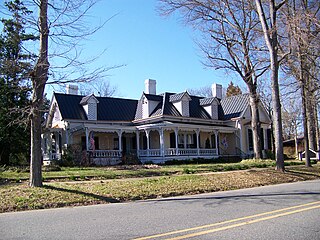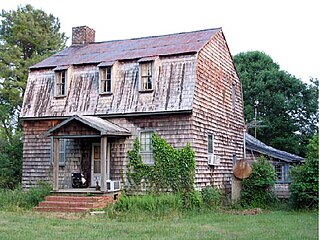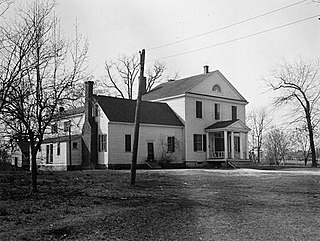Idlewild, also spelled Idlewyld, Idyllwild, Idyllwyld, Idylwild, or Idylwyld might refer to:
Idlewild, also known as the Downman House, was a historic home located at Fredericksburg, Virginia. It was built in 1859; a fire in April 2003 destroyed most of the interior and collapsed the roof. It was a 2+1⁄2-story, Gothic Revival-style brick dwelling with an English basement and an irregular "T" shape with a center passage plan. The house was topped by a steep slate gable roof. Also on the property at present are three contributing brick dependencies and a contributing pet cemetery. During the American Civil War, Idlewild became a prominent landmark on 4 May 1863, during battle action related to the Chancellorsville campaign. On that evening Confederate General Robert E. Lee used the house as his headquarters, after being initially occupied that day by Federal troops of the Union Sixth Corps.

The Albert Swain Bryson House, known locally as Hall of the Pines, is a historic house in Franklin, North Carolina. The 2+1⁄2-story brick and frame house occupies a prominent site on Pine Lane overlooking Main Street. It was built in the 1870s for Albert Swain Bryson, a prominent local farmer and magistrate. The house is a regionally rare example of vernacular Gothic and Italianate style, with steeply-pitched gables decorated with paired brackets, and a two-level porch with delicate sawn balustrade.
Charles T. Holt House is a historic home located at Haw River, Alamance County, North Carolina. It was designed by architect George Franklin Barber and built in 1897. The house is a 2+1⁄2-story, rectangular dwelling sheathed in wood, slate, brick and stone in the Queen Anne style. It features peaks, turrets and decorative chimney stacks. Also on the property are the contributing carriage house, servant's quarters, gas house, corn crib, barn, and well house. It was built for textile businessman Charles T Holt, the son of Thomas Michael Holt, governor of North Carolina, and his wife Gena Jones Holt, the daughter of Thomas Goode Jones, governor of Alabama.
King-Freeman-Speight House, also known as Francis Speight House, is a historic plantation house located at Republican, Bertie County, North Carolina. It was built in two sections, with the oldest built between 1808 and 1828. The older section forms the basis of the current rear wing. About 1828, a 2+1⁄2-story, Federal style, side-hall plan was added at a right angle to the original structure. The house was enlarged and remodeled in 1907. It has a two-story, two-bay addition and a two-story rear addition built in 1855. It features a hip roof front porch. Also on the property are the contributing two smokehouses, the kitchen, and an office. Noted landscape artist Francis Speight was born in the house in 1896.
Gunston Hall, also known as Franklin Hall, is a historic estate and a national historic district located at Biltmore Forest, Buncombe County, North Carolina. The district encompasses five contributing buildings, one contributing site, and two contributing structures. The main house was designed by architect Waddy Butler Wood and built in 1923. It is a five-part Colonial Revival style dwelling consisting of a 1+1⁄2-story main block flanked by hyphens and 1+1⁄2-story wings. The grounds were designed by noted landscape architects Chauncey Beadle and Lola Anderson Dennis. Other contributing elements are the Grounds and Garden, the Breezeway, Gazebo, Tool Shed/Potting Shed, Greenhouse, Garden Shed, and Entrance Piers and Gates (1923). The estate was built by Dr. William Beverley Mason, a great-great grandson of George Mason, who built Gunston Hall (1759).

Dr. Joseph Bennett Riddle House is a historic home located at Morganton, Burke County, North Carolina. It was built about 1892, and is a 2+1⁄2-story, five-bay, Queen Anne style frame house. It features a number of balconies, bay windows, and dormers. A three-story tower was added in about 1910.

Dr. Glenn R. Frye House is a historic home located at Hickory, Catawba County, North Carolina. It was built in 1937, and is a two-story, Colonial Revival style stone dwelling. It has a 1+1⁄2-story frame wing. Also on the property are the contributing garage (1937); wrought-iron balustrade, fence, and gates (1937); and stone wall (1937).
William Pinckney Reinhardt House, also known as the Pink Reinhardt House, Reinhardt-Sigmon House, and Sigmon House, is a historic home located near Maiden, Catawba County, North Carolina. It was built about 1845, and is a two-story, Greek Revival style frame dwelling. The front facade features center bay portico supported by two stuccoed-brick Doric order columns and a sophisticated Asher Benjamin-inspired doorway. It has a 1+1⁄2-story frame addition built in the 1920s. It is nearly identical to the neighboring Franklin D. Reinhardt House.

Dr. Victor McBrayer House, also known as Owen House, is a historic home located near Shelby, Cleveland County, North Carolina. It was built in 1893, and is a 1+1⁄2-story, modified "U"-plan, eclectic frame dwelling with Italianate, Gothic Revival, and Queen Anne style design elements. It features a rich array of sawn and turned ornament.

Dr. Earl S. Sloan House is a historic home located at Trent Woods, Craven County, North Carolina. It was built in 1914, and is a 2+1⁄2-story brick dwelling, consisting of a main block and flanking pavilions under low, hipped slate roofs. It is a Colonial Revival style residence with Tudor Revival and Mediterranean style design influences.

The Andrews-Moore House is a historic plantation house located near Bunn, Franklin County, North Carolina.

Shemuel Kearney House was a historic plantation house located near Franklinton, Franklin County, North Carolina, formerly at 2555 U.S. Highway 1 south of town. In 2009, the house was dismantled and moved to nearby Louisburg for restoration as the original property was recently zoned by Franklin County for commercial use. Therefore, the building had to be relocated. The Shemuel Kearney House was reconstructed next to another historic residence, the Cooke House, on Peach Orchard Road in 2015.

Green Hill House is a historic plantation house located near Louisburg, Franklin County, North Carolina. It was built prior to 1785, and is a 1+1⁄2-story, three-bay, Georgian style frame dwelling. It sits on a raised basement and has a rear shed extension. The house features large double-shoulder brick end chimneys. Green Hill (1741-1828) was active in the Methodist movement and his house was the scene in 1785 of the first annual conference of the newly organized Methodist Episcopal Church, attended by Bishop Francis Asbury and Bishop Thomas Coke.

Person Place, also known as Prudence Person House, is a historic home located at Louisburg, Franklin County, North Carolina. It consists of a large two-story, three-bay, Federal style main block built about 1789, with a 1+1⁄2-story, three-bay Georgian wing. The front facade features a small three bay pedimented porch supported by four wooden Doric order columns. It also has two brick chimneys with concave shoulders.
Dr. John B. Seavey House and Cemetery is a historic plantation house located near Harrells, Sampson County, North Carolina. The house was built in 1841, and is a 2+1⁄2-story, single pile, Greek Revival style frame dwelling. The front facade features a two-tier front portico. The interior follows a central hall plan. The house is attributed to builder Isaac B. Kelly, who also built the James Kerr House. Also on the property are the contributing grape arbor, a smokehouse, a barn, and family cemetery, which are the only surviving outbuildings.
James Kerr House is a historic plantation house located near Kerr, Sampson County, North Carolina. The house was built in 1844, and is a 2+1⁄2-story, five bay by two bay, Greek Revival style frame dwelling. It has a gable roof, 2+1⁄2-story rear ell, brick pier foundation, and a pillared double-tier porch central porch. The interior is center-hall in plan. The house is attributed to builder Isaac B. Kelly, who also built the Dr. John B. Seavey House. Also on the property are the contributing original detached kitchen and frame smokehouse.
Mary Ann Browne House, also known as Oakley, Oakley Grove, Faulcon-Browne House, and Dr. LaFayette Browne House, is a historic plantation house located near Vaughan, Warren County, North Carolina. It consists of a 2+1⁄2-story, Italianate style rear wing built about 1800, with a main block added about 1855. The main block is attributed to Warrenton builder Jacob W. Holt. It is a two-story, three-bay, single pile, Greek Revival / Italianate style frame block. It has a low hipped roof and Tudor arched windows.

The Maple Street–Clarks Avenue Historic District encompasses a historic 19th-century immigrant neighborhood of St. Johnsbury, Vermont. Located northwest of the downtown area on a sloping hillside, it consists of tenements and single-family houses built for Irish and French Canadian immigrants, sometimes grouped in ways that facilitated the support of large extended families. The district was listed on the National Register of Historic Places in 1994.














